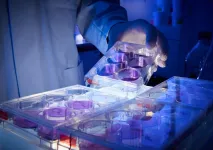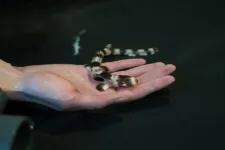(Press-News.org) Antibodies are an important weapon in the immune system's defense against infections. They bind to the surface structures of bacteria or viruses and prevent their replication. One strategy in the fight against disease is therefore to produce effective antibodies in large quantities and inject them into the patients. The outgoing US President Donald Trump probably owes his rapid recovery to this method. However, the antibodies used to treat him have a complex structure, do not penetrate very deeply into the tissue and may cause unwanted complications. Moreover, producing antibodies is difficult and time-consuming. They are therefore probably not suitable for widespread use.
Mass production in yeast or bacteria
"We focus on another group of molecules, the nanobodies," explains Dr. Florian Schmidt, who heads an Emmy Noether group on this promising new field of research at the University of Bonn's Institute of Innate Immunity. "Nanobodies are antibody fragments that are so simple that they can be produced by bacteria or yeast, which is less expensive."
However, the immune system produces an almost infinite number of different antibodies, and they all recognize different target structures. Only very few of them are for example capable of defeating the SARS coronavirus-2. Finding these antibodies is like searching for a single grain of sand on Germany's Baltic coast. "We first injected a surface protein of the coronavirus into an alpaca and a llama," Schmidt explains. "Their immune system then produces mainly antibodies directed against this virus. In addition to complex normal antibodies, llamas and alpacas also produce a simpler antibody variant that can serve as the basis for nanobodies."
A few weeks later, the researchers took a blood sample from the animals, from which they extracted the genetic information of produced antibodies. This "library" still contained millions of different construction plans. In a complex process, they extracted those that recognize an important structure on the surface of the coronavirus, the spike protein. "Altogether we obtained dozens of nanobodies, which we then analyzed further," explains Dr. Paul-Albert König, head of the Core Facility Nanobodies at the Medical Faculty of the University of Bonn and lead author of the study.
Four out of several million
Four molecules actually proved to be effective against the pathogen in cell cultures. "Using X-ray structures and electron microscopy analyses, we were furthermore able to show how they interact with the spike protein of the virus," explains König. This work was done in the research groups around Martin Hällberg (Karolinska Institutet, Sweden) and Nicholas Wu as well as Ian Wilson (Scripps Research Institute, USA). The spike protein is crucial for the infection: It acts like a velcro fastener with which the pathogen attaches to the attacked cell. Next, the velcro changes its structure: It discards the component that is important for attachment and mediates fusion of the virus envelope with the cell. "Nanobodies also appear to trigger this structural change before the virus encounters its target cell - an unexpected and novel mode of action," says König. "The change is likely to be irreversible; the virus is therefore no longer able to bind to host cells and infect them."
The researchers also exploit another major advantage of nanobodies over antibodies: Their simple structure allows straight forward combinations to form molecules that can be several hundred times more effective. "We have fused two nanobodies that target different parts of the spike protein," explains König. "This variant was highly effective in cell culture. Furthermore, we were able to show that this drastically reduces the probability of the virus to become resistant to the active agent through escape mutations." The researchers are convinced that the molecules may be developed into a novel and promising therapeutic option.
Dioscure Therapeutics, a spin-off of the University of Bonn, will test the nanobodies in clinical studies. The success of the project is mainly based on the excellent cooperation of the participating research groups at the University with national and international cooperation partners, emphasizes Florian Schmidt, who is also a member of the Immunosensation2 Cluster of Excellence at the University of Bonn.
INFORMATION:
About the cooperation:
Institutions from Germany, Sweden and the USA were involved in the study. Diffraction data were collected at Stanford Synchrotron Radiation Lightsource (SSRL) and at the Advanced Photon Source (APS) at Argonne National Labs in the USA.
In Germany, the study was financially supported by the Medical Faculty of the University of Bonn, the German Research Foundation, the Klaus Tschira Boost Funds, the Federal Ministry of Education and Research, the Baden-Württemberg Foundation and the MWK Baden-Württemberg. In the USA, the Bill and Melinda Gates Foundation, the U.S. Department of Energy, the National Institutes of Health (NIH), the National Institute of General Medical Sciences (NIGMS) and the National Cancer Institute (NCI) funded the project, in Sweden the Swedish Research Council and the Knut and Alice Wallenberg Foundation.
The founders of the company Dioscure were supported by the enaCom Transfer Center at the University of Bonn providing a link between research and industry with its offers. As University of Bonn's IP Service Provider, PROvendis GmbH negotiates the commercialization contract with Dioscure.
Publication: Paul-Albert König, Hrishikesh Das, Hejun Liu, Beate M. Kümmerer, Florian N. Gohr, Lea-Marie Jenster, Yonas M. Tesfamariam, Lisa D.J. Schiffelers, Miki Uchima, Jennifer D. Wuerth, Karl Gatterdam, Natalia Ruetalo, Maria H. Christensen, Caroline I. Fandrey, Sabine Normann, Steffen Pritzl, Jan M. P. Tödtmann, Leo Hanke, Jannik Boos, Meng Yuan, Xueyong Zhu, Jonathan Leo Schmid-Burgk, Hiroki Kato, Michael Schindler, Ian A. Wilson, Matthias Geyer, Kerstin U. Ludwig, B. Martin Hällberg, Nicholas C. Wu and Florian I. Schmidt: Structure-guided multivalent nanobodies block SARS-CoV-2 infection and suppress mutational escape. Science; DOI: 10.1126/science.abe6230
Researchers at Karolinska Institutet in Sweden have developed, in collaboration with researchers in Germany and the U.S., new small antibodies, also known as nanobodies, which prevent the SARS-CoV-2 coronavirus from entering human cells. The research study, published in Science, shows that a combined nanobody had a particularly good effect - even if the virus mutated. According to the researchers, the nanobodies have the potential to be developed into a treatment for COVID-19.
Specific proteins, spike proteins, on the surface of the SARS-CoV-2 coronavirus help the virus infect host cells. Therefore, antibodies that block the spike proteins and prevent them from binding to the cell can be a way to stop infection.
From the perspective ...
What will the SARS-CoV-2 outbreak look like ten years from now as it passes from pandemic to endemic, maintained at a constant baseline level in populations without being fueled by outside infections? Data from four endemic human coronaviruses, which circulate globally and cause only mild symptoms, may hold some answers, say Jennie Lavine and colleagues. Their analysis of the immunological and epidemiological data for these viruses helped them develop a model to predict the trajectory of SARS-CoV-2 as it becomes endemic. Most importantly, the authors say, their model incorporates distinct components of immunological protection--susceptibility to reinfection, weakening of the disease after reinfection, and transmissibility of the virus after reinfection--that each wane differently. Lavine ...
An immunization strategy tested in mice protects against infection from SARS-CoV-2, as well as from potentially emerging animal coronaviruses, researchers say. The approach could be "used as described or easily adapted" to provide defense against newly discovered zoonotic coronaviruses. In the last 20 years, three betacoronaviruses have caused devastating disease in humans. The global pandemic caused by the latest such virus, SARS-CoV-2, highlights the need to protect against other strains that could present a threat to humans, possibly through a pan-coronavirus vaccine. To support related efforts, ...
Thanks to major progress in the understanding and management of rare congenital diseases and syndromes, many patients with these rare disorders are now living longer lives. With this progress it has become apparent that many non-skeletal rare diseases have an impact on bone mass, bone quality and/or bone metabolism, with potentially severe repercussions for quality of life in adults.
The new paper 'Bone fragility in patients affected by congenital diseases non skeletal in origin', published in Orphanet Journal of Rare Diseases by the International Osteoporosis Foundation (IOF) Skeletal Rare Diseases Working Group (SRDWG), provides ...
Most people experience turbulence primarily from the experience of flying in an airplane. However, turbulence is a key feature of nature and is found everywhere, from rivers to galaxies.
Turbulent-like dynamics are difficult to capture in a still image. However, Leonardo da Vinci did everything possible to identify the underlying order of the phenomenon, which he observed in eddy currents forming randomly in water. In fact, he was fascinated by trying to understand and describe the generating principles governing such complicated dynamics. This is so much ...
Scientists are combining artificial intelligence and advanced computer technology with biological know how to identify insects with supernatural speed. This opens up new possibilities for describing unknown species and for tracking the life of insects across space and time
Insects are the most diverse group of animals on Earth and only a small fraction of these have been found and formally described. In fact, there are so many species that discovering all of them in the near future is unlikely.
This enormous diversity among insects also means that they have very different life histories and roles in the ecosystems.
For ...
A new study conducted at the New England Aquarium finds that as climate change causes the ocean to warm, baby sharks are born smaller, exhausted, undernourished, and into environments that are already difficult for them to survive in.
In a recently published paper in the journal Scientific Reports, lead author Carolyn Wheeler, a Ph.D. candidate at the University of Massachusetts Boston and at the ARC Centre of Excellence for Coral Reef Studies at James Cook University, examined the effects of increased temperatures on the growth, development and physiological performance of epaulette ...
It's been more than a year since the first cases were identified in China, yet the exact origins of the COVID-19 pandemic remain a mystery. Though strong evidence suggests that the responsible coronavirus originated in bats, how and when it crossed from wildlife into humans is unknown.
In a study published online Jan.12 in the journal mBio, an international team of 15 biologists say this lack of clarity has exposed a glaring weakness in the current approach to pandemic surveillance and response worldwide.
In most recent studies of animal-borne pathogens with the potential to spread to humans, known as zoonotic pathogens, physical specimens of suspected wildlife ...
Exercising regularly is one of the best defences against metabolic diseases, such as obesity and diabetes - but why? It's a question that scientists are still struggling to answer. While exercising changes the molecular behaviour of muscles, it's not well understood how these molecular changes improve metabolic health.
Scientists at the University of Copenhagen have now developed a new technology that allows researchers to study muscle biology on a more detailed level - and hopefully find some new answers. They extracted 'fast' and 'slow' twitch muscle fibers from freeze-dried muscle samples that were taken before and after 12 weeks of cycling exercise training. Their comprehensive analysis of the protein expression of the fibers provides new evidence that the ...
BOSTON -- By mid-November, the Centers for Disease Control and Prevention had reported that 218,439 health care workers in the U.S. had been infected with COVID-19 -- a likely underestimate due to incomplete data from states. About 3% to 4% of health care personnel who recover from coronavirus infection are expected to become "COVID long-haulers" as they cope with debilitating symptoms 12 to 18 months after the acute stage of the infection clears.
"As COVID-19 surges again, hospitals are facing a shortage of skilled frontline providers who can meet the relentless demands of caring for these patients," says Zeina N. Chemali, MD, MPH, a psychiatrist and neurologist at Massachusetts ...


